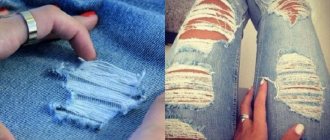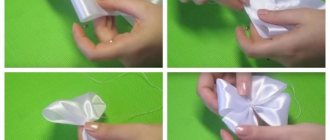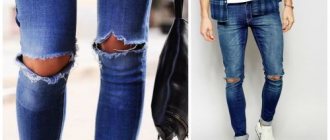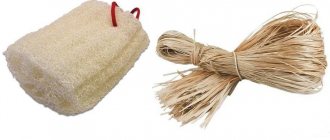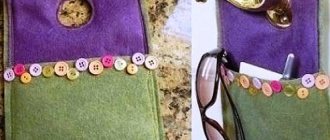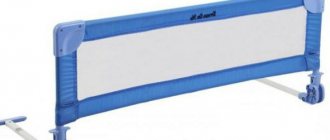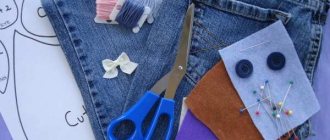Holes and fraying in denim are becoming more common every day and continue to uncontrollably gain popularity. However, in stores such a thing is quite expensive, but you can make it from existing jeans. In our article we will tell you how and with what tools you can make holes and frays on jeans, how to decorate them, and what not to do when turning them into a fashion trend.
Why put holes in jeans?
Jeans with holes and fraying have been actively acting as a fashion trend for quite a long time, which stubbornly and confidently maintains a high position.
These pants are worn by actors, singers and other celebrities from all over the world. Self-made holes and frays turn jeans into an exclusive item.
Decorating ripped jeans
Modern trends in the fashion world allow you to give imagination in all its manifestations. You can decorate ripped jeans in one of the most popular options - using lace:
Slits look great on faded jeans. To achieve this color, you can place individual sections of the trousers in water diluted with regular white, or walk a sponge soaked in this liquid along the entire length:
Which jeans models to choose for the ripped version
We create torn and frayed jeans based on: boyfriend jeans, loose-fitting jeans, classic or cropped versions. If there is a need to make holes in skinny pants, we do this with extreme caution. In areas where the fabric is very tight (such as the thighs), the tight skin may appear through the holes, as if “falling out”. We also take into account the characteristics of the fabric - its density, ability to stretch, and others. For example, if the fabric is stretch, if it is stretched significantly, the hole may enlarge or become deformed.
Hole jeans: for those who are on trend
In the 70s and 80s, ripped jeans were an exclusively subcultural phenomenon. They were worn by hippies and punks. The pants, torn at the knees, had a kind of rebellious message. “Ordinary people” did not dare to follow their example, so as not to be included in their ranks for such a reason as holey jeans. Scuffs and slits on pants began to gain popularity among young people in the 90s with the advent of the grunge style, but even at that time they remained something outlandish and bold.
The designers of the Dolce&Gabbana Fashion House noticed the interest of young people in torn jeans. Italian designers were the first to introduce a new trend in their collections; this happened in the early 2000s. Hole jeans have become the basis of a new style - glamorous grunge. The “holeiness” from the legs spread to other items of clothing - sweaters, T-shirts and even tights.
The trend quickly spread across our country. Nowadays not only young people, but also representatives of the middle generation wear torn jeans. Torn pants are also presented in children's clothing collections. And if 10 years ago this trend was criticized, today the attitude towards it has become calmer, and the indignation of the older generation has subsided.
How to make smooth and beautiful holes in jeans
We try on jeans and draw marks where we want to make holes. Place a piece of plywood or a board under the desired area of fabric. Using a knife or blade, we make small cuts of the same size parallel to the white longitudinal threads. We cut carefully so as not to damage the threads. Use scissors to grab and pull out the white threads a little. Then we pull out the blue transverse threads with tweezers. Thus, we get a hole covered with white threads. If you need to make a full hole, cut off the little white threads and process the edges of the hole.
Tools for perfect holes
There are many ways to tear jeans fashionably. But to create truly beautiful trousers, it is important to adhere to the following rules:
- The “golden mean” is above all. If you go too far with the number of holes or their size, your jeans will look sloppy.
- It is better to think through the concept in advance. Lay your pants out on a flat surface and show them off in front of the mirror. It is important to determine where the slots will be . Here, there are practically no limits to your imagination: some make their trousers with holes along their entire length, some prefer to bare their knees, and the bravest ones cut them on the buttocks. The main thing is to know which part of the body deserves close attention.
- When the general idea has matured in your head, it is important to transfer it to jeans. In order not to spoil the work at the very beginning, it is better to mark the intended cuts with chalk or a felt-tip pen.
If everything is ready, you need to decide on the tools for the job. Fortunately, their selection is extensive. Particularly popular are:
- grater;
- sandpaper;
- pumice;
- blade;
- white;
- Crochet hook;
- scissors.
In addition, for ease of work you will need thread and a needle, chalk, and a solid cardboard base.
How to make fashionable holes
Any jeans with holes or fraying, regardless of their shape and type, are fashionable and stylish clothing. When cutting or wiping holes, take into account the following nuances:
- the holes should be located so that underwear and problematic parts of the body are not visible;
- We make not one hole, but several, so that the holes cover different areas of the product.
Particularly popular are holes with white edging or covered with longitudinal white threads.
On a note!
A hole in which there are no clear lines and cuts is considered fashionable; it should be accompanied by the effect of wear and tear.
To make such a hole in your pants, draw its intended shape on the fabric. We place a board or plywood under the fabric, using a scalpel or blade, we make longitudinal cuts of different lengths. We pull out the dark transverse threads with tweezers, and cut the longitudinal ones in the right places. We rub the edges with a nail file and pull out some of the threads to make the hole look more frayed. To prevent the hole from becoming deformed in the future, we stitch the edges or cover the inside of the fabric with non-woven material.
We can replace the scalpel and knife with scissors - we cut out a hole of the required size and shape, and then we process the edges with a nail file and tweezers.
Jeans with holes in the butt
We make holes and fraying on the butt directly on the pockets themselves. Take a pumice stone, a blade and tweezers. We place plywood under the pocket fabric and use a blade to make longitudinal cuts of different lengths. Then rub them with pumice until holes form. We remove excess white threads with tweezers, if desired.
Pumice can also be replaced with sandpaper. After making the cuts, we collect the fabric using bobby pins so that folds are formed. We lightly moisten it and use three sandpaper until it looks frayed.
How to make holes in your knees
We place the holes on the knees slightly above or below the level of the knee, since during walking they increase in size and become deformed. But if you still decide to make them on the knee so that it can be seen entirely, then the shape should be chosen rectangular or round.
We make marks on the product, cut out a hole, then sand the edges with fine-grain sandpaper and remove excess white threads. Additionally, we wet the edges and secure them with paper clips. Let it dry and enjoy the fashionable item you have created.
On a note!
We cut only the white threads that are too long, leaving the short ones as they will give the product more style.
The holes in your jeans can be added with distresses to give them an even more distressed and stylish look.
What will you need for work?
Before starting the work process, it is necessary to mark on the fabric the places where the holes will be located, as well as determine their number and shape . The appearance of clothing and wearing comfort depend on this.
Important! For many, it may seem that making a hole in denim trousers is easy. But if this procedure is carried out incorrectly, the product may turn out to be unoriginal and cause laughter among others.
There are several ways to decorate pants with slits, each of which differs in production technology and requires attention, as well as a certain amount of time. It is recommended to carry out the work using some tools that will help create the intended pattern on the pants, as well as design it effectively. Such devices include:
- manicure and large scissors;
- brush with metal teeth;
- sandpaper;
- tweezers;
- needle;
- chalk or marker;
- stationery knife or blade;
- wooden, plastic or cardboard lining.
Attention! In order not to touch the other side of the pants with a sharp object when making cuts, it is necessary to use a thick board, which will prevent such a problem and help make the hole of the desired shape.
How to Create Holes and Fades in Jeans - Step-by-Step Guide
We also make torn and frayed jeans using pumice, emery, bleach and other available materials. But this is too time-consuming and labor-intensive, so it is better to use them to create frayed areas.
Using sandpaper
Sandpaper can significantly age the fabric and makes the fraying on jeans quite deep.
On a note!
The grit of sandpaper used depends on the thickness of the denim - the thicker the fabric, the larger the grit, and vice versa.
Take sandpaper, a board or piece of plywood and jeans. We soak the pants in water and wring them out thoroughly; they should become damp, not wet. We select an area on the fabric that we will rub and place a board under it. Distresses look good around the knee (above or below it), as well as on the back of the pockets. However, during the process of rubbing the fabric, we try not to touch the seams, as we risk getting unwanted holes. Three little by little, regularly checking the results of the work done.
Advice!
We leave the frayed ones a little more intact than we would like, since they themselves will become more dilapidated over time.
We wash the jeans, dry them, evaluate the result and repeat the procedure.
Using a razor
First, we mark the necessary places on the fabric. Place cardboard underneath the material. We run the razor blade along the marked area, and hold the fabric with the other hand. Don't forget to clean the blade to keep it sharp.
Using a crochet hook
You can use a crochet hook to imitate a rip in factory-made jeans. Denim fabric consists of longitudinal (white) and transverse (blue) threads. By removing the blue threads, we create stylish scuff marks. We mark with chalk or a pen where they will be and draw out the transverse threads with a crochet hook.
Using bleach
To create frayed areas with bleach, we use any abrasive, even chlorine. First, we mark suitable areas of the fabric and treat them with bleach. Additionally, if necessary, we use pumice and emery.
Advice!
We carry out the entire procedure with gloves so as not to damage the skin of the hands.
Chlorine bleach will make the fabric lighter and softer, and since it breaks down the fibers of the fabric, holes will appear in the treated areas during wear.
Using pumice
Pumice stone allows you to create delicate and smaller frayed areas. The algorithm for its use is identical to sandpaper. With its help, you can make the product more worn by running it along the entire length of the pants. Pumice and sandpaper can be combined to create different levels of abrasion.
Advice!
When using emery after pumice, use little effort, otherwise you risk rubbing holes in your pants.
Preparatory stage
You can change the appearance of your trousers very simply; you will only need the usual means at hand. Take your old and worn pants and follow a few simple steps.
Trying on, choosing and designating the location for the hole
First of all, you should try on old things. This way, you can evaluate exactly how the pants will look after the transformation. Think in advance about what specific result you want to achieve. Much depends on the quality of the material, which reacts differently to cuts and damage.
The hole can become deformed and grow. When trying on, make sure where the cuts will be located. Consider not only the characteristics of your anthropometric data, but also the density of the material itself. Mark the area of future holes using white chalk, as it is clearly visible against any background.
Preparing the necessary tools and materials
There are several ways to make a cut on jeans. To do this, you must take the following available items:
- Large and manicure scissors.
- A brush.
- Sandpaper.
- Needle and tweezers.
- Stationery knife (alternative - blade).
- Material that can be placed under a trouser leg.
What should you not do?
Create abrasions on the seams, especially on those that connect the parts of the pants, otherwise a hole will form there, which will significantly reduce the “service life” of the product.
Making holes in the buttocks. It looks ridiculous and not everyone likes the contemplation of underwear peeking out. In addition, when squatting there is a risk of making the hole even larger.
Take too worn and old jeans as a basis.
How to finish the edges
After mechanical impact on the material, you should immediately put the trousers in the machine - washing will complete the result of your efforts. Then go over the jeans with a hot iron.
Also, if you wish, you can treat the “scratches” with a whitening solution, highlighting the selected areas. The substance should be mixed in equal proportions with water and applied with a sponge.
Additional questions
What to wear with faded jeans? – T-shirts, T-shirts, blouses, ballet shoes, sandals and high-heeled shoes, jackets, jumpers, jackets, knitted and other items.
How to choose the correct shape and location of holes? – we rely on the features of the figure, the style of the jeans and the fabric of the product. Next, we look for photos of similar models on the Internet, choose the one we like and start creating a masterpiece.
How to wash holey jeans? – We wash it in a machine, after placing the product in a special bag, we use the delicate mode.
Neat abrasions
If you are not a fan of radical methods of updating things, you can make neat scuffs. Work with the materials described above.
Draw with chalk the areas where there will be abrasions. Place cardboard or a board inside the trouser leg, treat the area outlined with chalk with a pumice stone, a block or a grater. Do not overdo it, otherwise you will wear the fabric through to holes.
Want to achieve a worn-out effect? Use sandpaper or a block. A pumice stone or a kitchen grater will help to make abrasions with braid.
When working with dry denim, debris appears that settles on the carpet, so it is better to slightly moisten the jeans. Various decorative elements add flair to the product and are a stylish addition. Fashionistas use fabric painting, rhinestones, rivets and even paper clips.
SHEIN Ripped jeans with chain RUB 1,530 SHEIN Ripped skinny jeans plus size RUB 1,510
-26%
SHEIN Ripped jeans plus size RUB 1,300 RUB 1,750 SheIn Ripped jeans with zipper RUB 1,218
-32%
SHEIN Ripped jeans plus size RUB 1,140 RUB 1,680
-29%
NaaNaa Blue bleached ripped skinny jeans with high waist NaaNaa-Blue RUB 1,690 RUB 2,390
Ways to decorate jeans
- lace;
Lace perfectly complements fraying and holes in jeans. It is sewn on the inside of the product and hides bare areas of the body. In addition, such inserts prevent damaged denim from deforming, spreading, and increasing in size.
On a note!
Lace can add romance and tenderness to an image.
- dyes;
Using various dyes, you can color the abrasions and edges of holes in denim. The choice of color depends on what clothes we will wear the product with.
- rhinestones;
We decorate the edges of the hole with rhinestones, and also use them to decorate other parts of the product.
- fabric inserts;
We sew fabric inserts on the inside of the product, thus closing the hole made.
- beads.
Beads are a popular decoration for ripped jeans. We first lay them out on the product and select the areas where we will sew them. Mark with a felt-tip pen or marker and sew on.
On a note!
We do not decorate back pockets with beads, as they can come off or cause discomfort while sitting.
Execution techniques
There are several ways to create rips and holes in jeans. Grunge style holes are made quickly and easily. Select an area, make holes, the distance between them is 5 mm. The threads located across the warp are carefully pulled out and removed.
The minimalist style is in fashion now, and this also applies to ripped jeans. Make small cuts in the marked places. Take out a little of the side threads without damaging the transverse ones. It’s great if the holes are located closer to the side seams of the pants.
Many young ladies do not stand on ceremony with the item when creating scuffs; the result is a strong tattered effect that does not spoil the product. The main thing is not to touch the transverse and longitudinal threads, which retain the shape of the product.
What to combine with torn and frayed jeans
Many girls would love to wear distressed jeans, but don’t know what to pair them with. If your pants have a lot of holes, wear plain T-shirts and raglans.
This does not mean that girls who prefer dressy things should give up such jeans. Worn trousers can be combined with blouses and heels.
Designers advise decorating worn areas with lace, embroidery, and beads; this adds femininity and coquetry.
Neat and beautiful holes on jeans will decorate the product, so in their creation, make an effort, use your imagination, in the end, everyone will be able to feel like a novice designer.
-20%
SHEIN Fashionable ripped jeans RUB 1,144 RUB 1,430
-72%
ASOS DESIGN Vintage Ripped Jeans ASOS DESIGN - Light Blue RUB 850 RUB 2,990
SheIn Ripped Jeans with Contrast Tape RUB 1,283 Aligne Rich Navy Organic Cotton Wide Leg Jeans with Pleated Front Aligne-Light Blue RUB 6,690
-20%
SHEIN Ripped skinny jeans with high elasticity RUB 1,168 RUB 1,460
-28%
New Look Maternity Blue ripped jeans New Look Maternity-Blue RUB 1,790 RUB 2,490
Where to buy fashionable ripped jeans?
You can find original models of stylish and inexpensive ripped jeans in our catalog using THIS LINK
ASOS DESIGN High Waist Vintage Jeans with Ripped Trim in Medium Wash ASOS DESIGN Hourglass - Light Blue RUR 2,190 River Island Maternity Gray Slim Fit Maternity Jeans with Ripped Trim and Raw Hem River Island Maternity Amelie - Gray RUR 4,190
-20%
SHEIN Ripped skinny jeans with pocket RUB 1,216 RUB 1,520
SheIn Fashionable ripped jeans RUB 1,420
-56%
Noisy May Black bleached jeans with ripped trim in vintage style Noisy May Brooke-Black RUB 1,490 RUB 3,390 Topshop Black jeans with ripped trim Topshop-Black RUB 4,490
Masking a hole without a patch
Not everyone likes patches on their knees; you can do without a patch. If your sewing machine has a forward-backward function, then darning will not be difficult.
Insert threads that match the color of the pants, set the widest stitch and sew back and forth until you have covered the entire hole. But this way you can only mend the smallest cut; for large holes you cannot do without patching.
To make the trousers look more original, add contrasting threads .
Ways to fill an old hole
Sometimes holes that appear accidentally or specially created eventually decide to be sealed. This will make the item more comfortable to wear or change its appearance. Moreover, depending on the choice of method and material for embedding, pants can be worn in the cold or warm season.
How to make a corner on a ceiling plinth with your own hands
Lace decoration
To create a delicate feminine wardrobe item, lace is used. There are several options for making a lace patch:
- a lace fabric is sewn on the back side above a round or square hole;
- lace stripes are made on the front surface of the pants (they can be located near the hole or directly above it);
- wear fishnet tights under trousers with holes.
The option of using tights is beneficial for those who prefer to change their look frequently. Another advantage of choosing it is that you don’t have to sew anything to the legs. A girl can wear trousers simply with holes or with lace decoration.
If you decide to use the option of sewing on a lace patch, then there are two options for attaching it:
- A patch slightly larger than the dimensions of the hole is cut out of lace fabric. The edge of the patch should be uneven and repeat the outline of the lace pattern. The decor is applied to the pants from the front side in the area of the hole, and machine stitched along the edge of the patch.
- The second option differs from the first in that the decor is sewn on the back side. In this case, there is no need to make an openwork edge of the patch. The threads for sewing are matched to the color of the jeans, and the seam is placed close to the edge of the hole.
On a note! If the trouser leg cannot be turned out so that the patch can be sewn on by machine, they work by hand without using a sewing machine.
Masking a hole with patches
Insulated patches above the hole are relevant in pants worn during the cold season. After making a hole using any of the methods described above and selecting a suitable fabric, work is carried out in this order:
- a patch is cut out of the prepared fabric, which is slightly larger in size than the hole, and its outline exactly repeats its shape;
- the workpiece is applied from the back side, pinned with pins;
- then the patch is basted with threads and the pins are removed;
- Now all that remains is to stitch the fabric to the denim trousers (the threads are matched to the color of the denim material, and the seam is laid as close to the edge of the hole as possible).
Advice! To make patches, colored or plain dense fabric is used. Flannel, knitted or knitted fabric will do.
